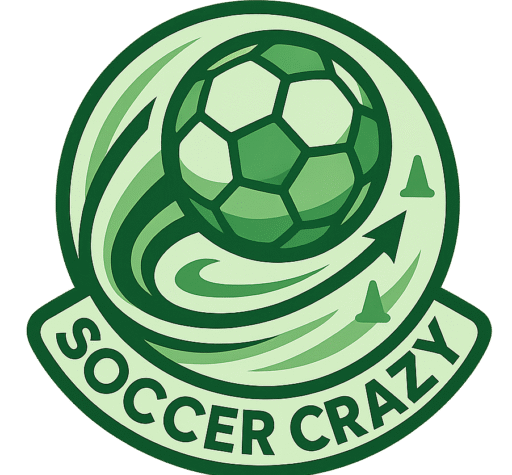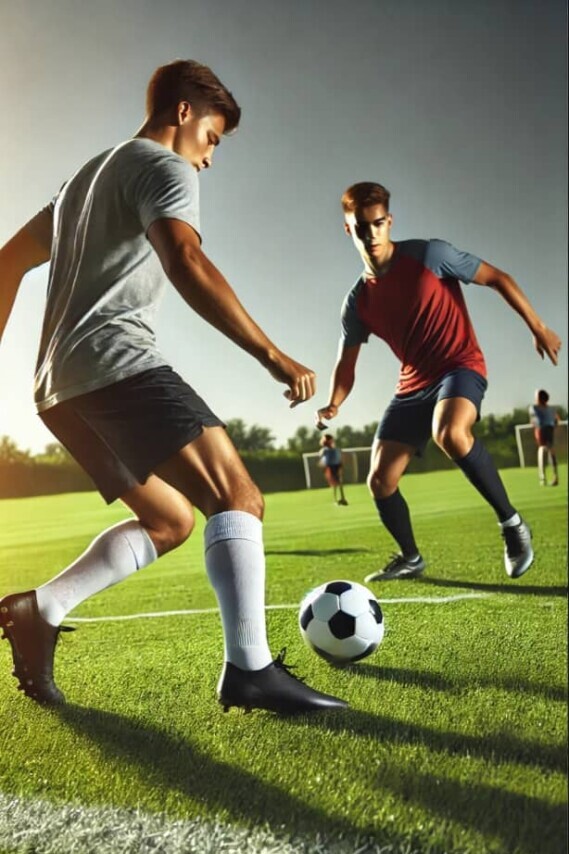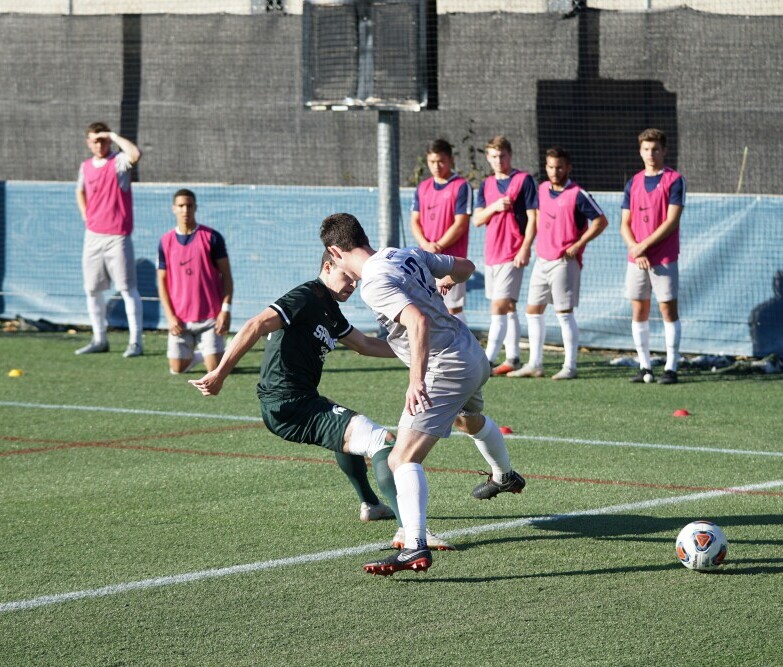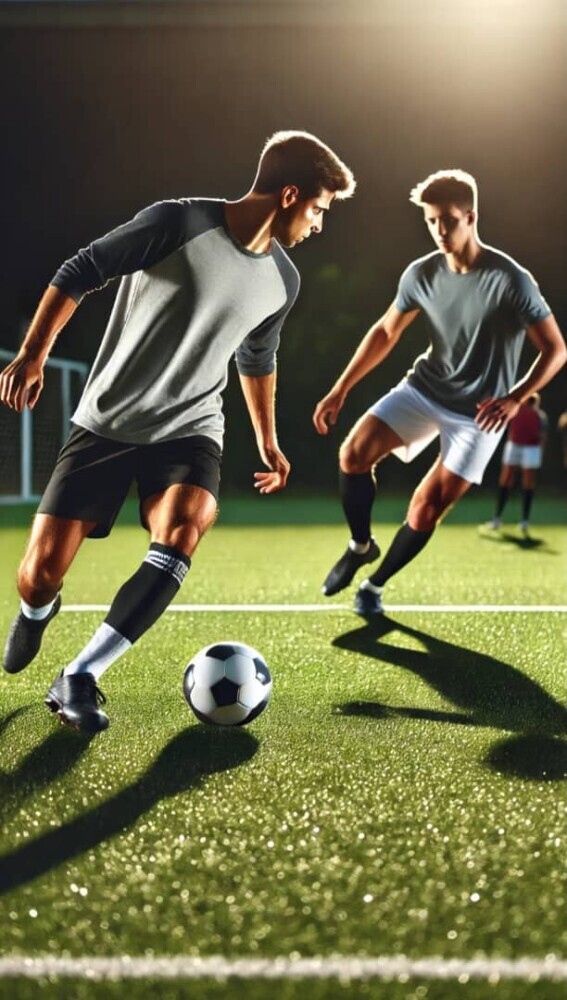Introduction to the 1v1 Dribbling Drill
The 1v1 Dribbling Drill is a crucial exercise designed to improve a player’s ability to take on defenders and enhance their defensive skills.
This drill focuses on developing quick decision-making, dribbling under pressure, and defensive tactics. It simulates real-game situations, helping players to become more confident and effective in one-on-one encounters.
Setting Up the Drill:
a)Equipment Needed:
- Soccer ball
- Cones (at least 4-6)
- A flat, open space (such as a soccer field or training ground)
b)Setup Instructions:
- Set up a small field or grid using cones, approximately 10 meters by 10 meters (33 feet by 33 feet). Adjust the size based on the players’ skill level.
- Place a goal (mini goals work well) at one end of the grid.
- Mark a starting point for both the attacker and defender about 5 meters (16 feet) apart.
Executing the 1v1 Dribbling Drill:
a) Starting Position:
- The attacker starts with the ball at one end of the grid.
- The defender starts at the opposite end of the grid, facing the attacker.
b)Dribbling Towards the Goal:
- Attacker’s Objective: The attacker dribbles the ball towards the goal, attempting to outmaneuver the defender and score.
- Using Both Feet: The attacker should use both the inside and outside of their feet to dribble, incorporating quick changes of direction and feints to deceive the defender.
- Close Control: Focus on keeping the ball close to your feet with small, controlled touches to maintain control under pressure.
- Decision-Making: The attacker must decide when to use speed, when to change direction, and when to take a shot at the goal.
c)Defending Against the Dribble:
- Defender’s Objective: The defender aims to prevent the attacker from scoring by blocking their path, stealing the ball, or forcing them to make a mistake.
- Positioning: The defender should stay low, balanced, and keep their body between the attacker and the goal.
- Anticipation: The defender must anticipate the attacker’s moves and react quickly to changes in direction.
- Tackling: Use clean, well-timed tackles to dispossess the attacker without committing a foul.
Advanced Variations:
a) Increase Speed:
- Gradually increase the speed at which the attacker and defender move to simulate more intense game conditions.
b)Multiple Attackers:
- Introduce a second attacker to create 2v1 situations, forcing the defender to make quick decisions about which player to mark.
c)Limited Touches:
- Limit the number of touches the attacker can take before attempting a shot, encouraging quick and precise dribbling.
d)Dynamic Defenders:
- Rotate defenders after each round to provide the attacker with different challenges and simulate various defensive styles.
Common Mistakes to Avoid:
a) Over-Reliance on Dominant Foot:
- Avoid using only your dominant foot. Ensure you’re developing skills in both feet for balanced dribbling ability.
b)Looking Down at the Ball:
- Constantly looking down at the ball can hinder your awareness of the defender. Practice keeping your head up to improve field vision.
c)Rushing the Drill:
- Don’t rush through the drill. Focus on maintaining control and making smart decisions rather than just speed.
Benefits of the 1v1 Dribbling Drill:
a) Improved Offensive Skills:
- Regular practice enhances your ability to take on defenders, make quick decisions, and score under pressure.
b)Enhanced Defensive Skills:
- Defenders improve their positioning, anticipation, and tackling abilities, making them more effective in one-on-one situations.
c)Increased Confidence:
- Mastering this drill boosts your confidence in both attacking and defending during actual game scenarios.
Incorporating the Drill into Your Training Routine:
a) Warm-Up: Use the 1v1 dribbling drill as part of your warm-up to get your muscles engaged and ready for more intense training.
b) Consistent Practice: Integrate this drill into your regular training routine, aiming for at least 10-15 minutes per session.
c) Progress Tracking: Record your progress, noting improvements in dribbling, decision-making, and defensive skills. Challenge yourself to reduce the time taken to complete the drill while maintaining precision.
FAQs
a) What is the 1v1 Dribbling Drill?
- Answer: The 1v1 dribbling drill is a practice exercise where one attacker dribbles the ball and attempts to get past a single defender. The defender’s objective is to prevent the attacker from advancing or scoring. This drill simulates real-game scenarios to improve individual offensive and defensive skills.
b)Why is the 1v1 Dribbling Drill important?
- Answer: This drill is crucial for developing a player’s ability to beat defenders, enhance their dribbling under pressure, and improve defensive skills such as tackling and positioning. It builds confidence, creativity, and resilience in competitive situations.
c)How do I set up the 1v1 Dribbling Drill?
- Answer: Set up a small playing area using cones to mark boundaries. One player starts with the ball (the attacker), and the other player (the defender) positions themselves a few meters away. The attacker tries to dribble past the defender to reach a designated end zone or goal.
d)What are the key techniques to focus on during the 1v1 Dribbling Drill?
Answer:
For Attackers:
- Use quick changes of direction and pace to unbalance the defender.
- Employ feints and skill moves to create space.
- Keep the ball close to your feet for better control.
For Defenders:
- Stay low and balanced to react quickly.
- Watch the attacker’s body movements and not just the ball.
- Use proper tackling techniques to dispossess the attacker without fouling.
e)How can I vary the 1v1 Dribbling Drill to make it more challenging?
- Answer: Increase the difficulty by reducing the size of the playing area, adding multiple defenders, or incorporating specific goals or targets for the attacker to reach. You can also time the drill to add pressure or require attackers to use certain skill moves.
f)What common mistakes should I avoid during the 1v1 Dribbling Drill?
Answer: Common mistakes include:
Attackers:
- Overcommitting and losing control of the ball.
- Not varying their speed or direction.
- Focusing too much on the defender rather than the space available.
Defenders:
- Diving in and getting beaten easily.
- Failing to maintain proper balance and positioning.
- Watching the ball instead of the attacker’s body movement.
g)How often should I practice the 1v1 Dribbling Drill?
- Answer: Incorporate the 1v1 dribbling drill into your training routine 2-3 times a week. Regular practice will help reinforce the skills and improve your overall performance in both offensive and defensive scenarios.
h)Can the 1v1 Dribbling Drill be adapted for team practice?
- Answer: Yes, this drill can be adapted for team practice by setting up multiple 1v1 stations or incorporating it into larger small-sided games. This encourages all players to engage in 1v1 situations, enhancing their individual skills within a team context.
i)What are the benefits of mastering the 1v1 Dribbling Drill?
Answer: Mastering this drill improves your ability to:
- Beat defenders and create scoring opportunities.
- Maintain control under pressure.
- Develop defensive skills to stop attackers effectively.
- Enhance overall game intelligence and decision-making.
j)How can younger players benefit from the 1v1 Dribbling Drill?
- Answer: Younger players can benefit by developing essential dribbling and defending skills early on. This drill helps them build confidence, improve their ability to read the game, and understand the importance of individual duels in soccer.
k)Are there any specific tips for advanced players practicing the 1v1 Dribbling Drill?
- Answer: Advanced players should focus on perfecting complex dribbling moves, increasing their speed and reaction time, and learning to anticipate the defender’s actions. Incorporating defensive strategies and counter-attacks can also add depth to their practice.
l)How does the 1v1 Dribbling Drill improve a player’s overall game performance?
- Answer: By enhancing individual skills, players can better handle one-on-one situations in real matches. This drill improves dribbling, tackling, decision-making, and the ability to stay calm under pressure, all of which are crucial for match-winning performances.
m)What variations of the 1v1 Dribbling Drill can be used for different positions?
Answer:
- Forwards: Focus on beating the defender and creating scoring opportunities.
- Midfielders: Emphasize maintaining possession and distributing the ball after beating the defender.
- Defenders: Work on positioning, tackling, and transitioning from defense to attack.
n)How can I track my progress in the 1v1 Dribbling Drill?
- Answer: Track progress by recording successful dribbles past the defender, successful tackles, and overall improvement in dribbling speed and control. Use video analysis to review and refine techniques.
0)Can the 1v1 Dribbling Drill be combined with other drills for a comprehensive training session?
- Answer: Yes, combine this drill with shooting drills, passing exercises, and small-sided games to create a comprehensive training session that addresses multiple aspects of the game. This integration helps players apply their 1v1 skills in various game situations.
Conclusion
The 1v1 Dribbling Drill is a versatile and effective exercise that enhances both offensive and defensive skills.
By consistently practicing this drill, you’ll develop superior control, agility, and confidence, essential attributes for any soccer player.
Whether you’re preparing for a match or simply looking to improve your overall game, this drill is an essential component of your training arsenal.
If you need further clarification on you have any questions, please leave them in the comment section below and I promise to get back to you.
Happy training.




This is excellent instruction, and my soccer-mad son loves it! I have a question about dominant feet. How on earth do you get a proper balance between using both feet? I’ve been trying to help my son, but he falls over whenever he focuses on using his left foot first. He’s getting distraught and threatening to give up. So, I thought I’d ask if you have any other tips!
I think he inherits his right-side dominance from me. My left side is much weaker, and I was told that it was a neurological imbalance. Could this be the case with my son?
Would appreciate you contacting me quickly!!
Thank you so much for your kind words!
I’m thrilled to hear that your soccer-mad son is enjoying the drill. I really appreciate you reaching out, and I can completely understand how frustrating it can be for him to feel challenged by his left foot.
Rest assured, you’re not alone—many players (young and experienced) struggle with balancing the use of both feet.
It’s great that you’re looking for ways to help him, and I’ll share a few tips that might make this process easier and less stressful for both of you.
1. Start Slow and Build Confidence:
When players first focus on their non-dominant foot, it’s normal for them to feel awkward and out of balance. The key is patience and gradual progress.
Encourage your son to slow down and practice simple movements at first—like dribbling in a straight line using only his left foot.
As he gets more comfortable, he can move on to more complex movements like turns or 1v1 dribbling.
Celebrate small improvements to boost his confidence, even if they feel minor!
2. Use Repetitive, Fun Drills:
Make it a game by setting challenges—like dribbling between cones using only his left foot for short bursts, or timing him to see how long he can keep the ball under control.
You could also play mini 1v1 games where he can only use his left foot. This helps build familiarity in a fun and engaging way without pressure.
3. Balance and Coordination Exercises:
It’s possible that his struggles could come from some level of coordination difficulty, which is common and can be improved with balance exercises.
Try having him stand on one foot (first on his left, then on his right) to build stability. Introducing basic agility ladder drills or even exercises like yoga can improve coordination over time.
4. Addressing Right-Side Dominance:
It’s not unusual for children (and adults) to have a more dominant side, and yes, in some cases, it could be linked to neurological factors. However, the brain is very adaptable, especially at a young age.
With practice and patience, your son can improve his control with his left foot, even if it feels unnatural at first. I’d suggest gentle, consistent practice sessions—a few minutes each day—rather than long, intense ones to avoid frustration.
5. Encourage Positivity and Patience:
It’s tough to see him get distraught, but remind him (and yourself) that learning new skills takes time, and even professional players have to work hard to become two-footed.
If he’s really frustrated, consider taking a break and focusing on his strengths (his right foot) for a little while. When he’s in a better mindset, you can revisit left-footed practice gradually.
You’re doing an amazing job supporting him, and the fact that you’re looking for ways to help speaks volumes.
Keep encouraging him and showing him that it’s okay to struggle—it’s all part of the learning process.
If you have any further questions or want to share how things are progressing, feel free to reach out anytime.
Wishing your son lots of success and joy on the field!
Great breakdown of the 1v1 Dribbling Drill! I really like how this drill focuses on both offensive and defensive skill development, which is crucial for game situations. I have a question: for younger or less experienced players, how would you recommend adjusting the drill to keep it challenging without being overwhelming? Also, do you have any tips for defenders to stay calm and composed while facing faster, more skillful attackers? Thanks for sharing this—it’s definitely something I’ll be incorporating into my training sessions!
Thank you Jonelle for your kind words! I’m glad you found the 1v1 Dribbling Drill useful, and I love that you’re thinking about ways to adapt it for different player levels.
For younger or less experienced players, I recommend starting with a simplified version. You could try:
Increasing space between players – Give them more room to operate so they have more time to react and think.Using a passive defender – Have defenders apply light pressure (without trying to win the ball immediately), helping the attacker build confidence.Shorter time frames – Let them dribble for shorter periods, so they focus on bursts of control instead of prolonged pressure.
As players progress, you can gradually reduce space and increase defensive pressure to make it more challenging.
For defenders facing faster, more skillful attackers, staying calm is key. Here are a few tips:
Maintain a low, balanced stance – This makes it easier to change direction quickly.Watch the attacker’s hips, not the ball – This helps prevent being tricked by feints or flashy moves.Be patient – Instead of lunging in, encourage defenders to guide the attacker into less dangerous areas or force a mistake through pressure.
I’m thrilled to hear you’ll be incorporating this drill into your sessions!